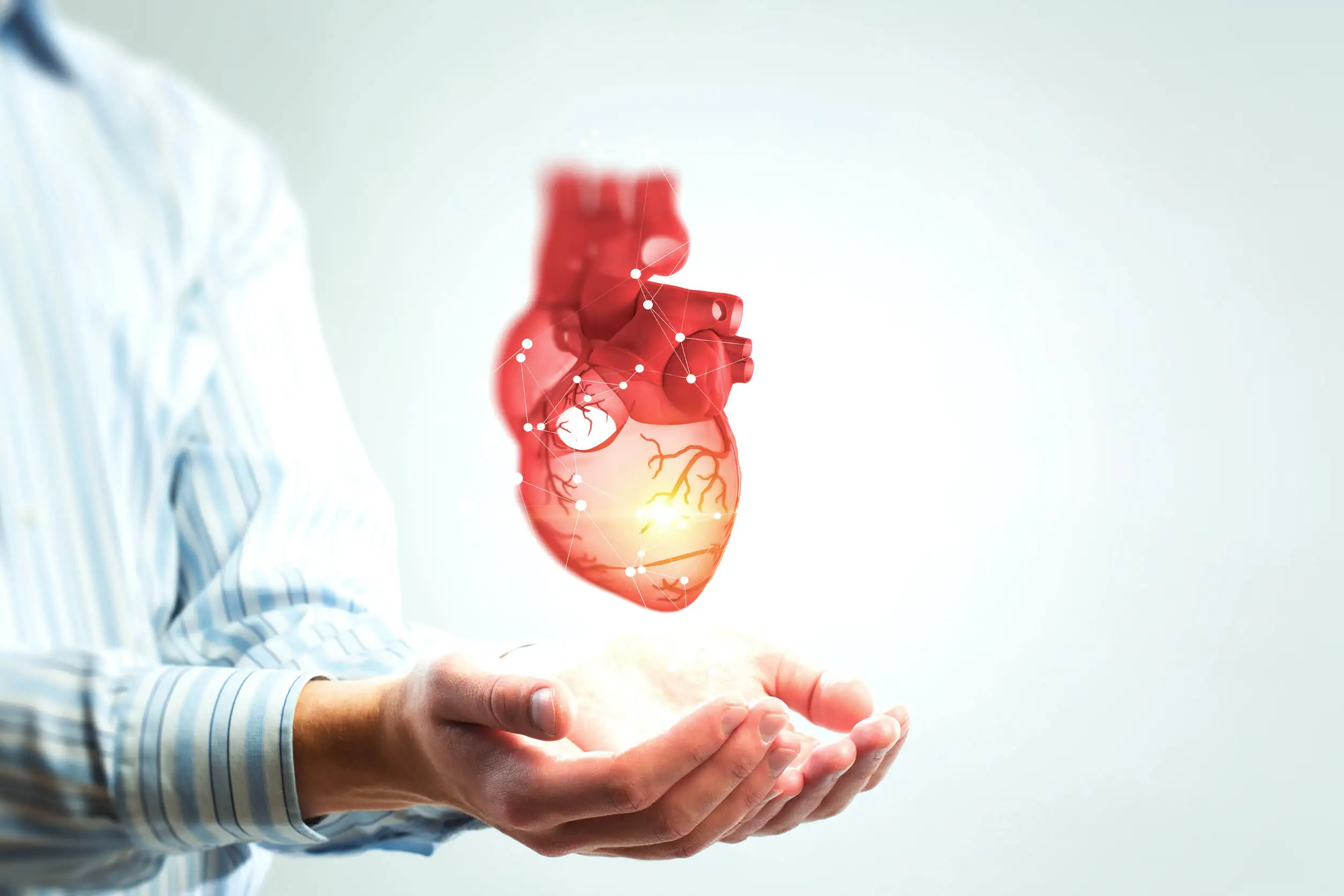Normal Heart Rate by Age and How to Calculate It

A normal heart rate can be defined as the number of times the heart beats per minute. To know our normal heart rate, we can use a device (pulsometer) or take our pulse manually on the wrist or neck.
This measurement should be done at rest and in activity to establish the minimum and maximum. Knowing this data is very important from the point of view of general health and for sports performance, since we could be exercising inadequately.
However, it should be noted that the normal heart rate may vary from one person to another. Also, factors such as age, sex, weight, and physical activity affect the beats per minute.
Normal heart rate by age
The concept of heart rate or pulse rate expresses the relationship between the number of heartbeats and a given period of time, which is usually 1 minute. This is an important indicator of the heart’s activity.
In particular, the normal heart rate refers to what is expected according to the age group to which we belong. It’s a measurement that should be taken as a reference, since there may be a variety of factors, circumstantial or inherent to the individual, that alter the rate.
In some, the pulse may be slightly faster; in others, it may be slower. Normal resting beats per minute (bpm) values are as follows:
- Newborns, up to the first month: 70 to 190 bpm
- Infants, up to one year: 80 to 160 bpm
- Children from 1 to 2 years old: 80 to 130 bpm
- Children between 3 and 4 years old: 80 to 120 bpm
- Children between 5 and 6 years: 75 to 115 bpm
- Children between 7 and 9 years old: 70 to 110 bpm
- Youth older than 10 years: 60 to 100 bpm
- Adults: 60 to 100 bpm
Heart rates tend to decrease as we get older.
What factors alter a normal heart rate?
When we move, the heart starts beating faster. Walking briskly, we will usually be between 80 to 120 beats per minute. Even the mere fact of eating already causes us to reach 70-100 beats per minute.
Of course, there’s a notable increase in heart rate during exercise. This is because physical activity increases the demand for energy and the heart has to work harder.
In this sense, depending on the level of intensity, the heartbeat accelerates and can reach up to 120-160. High-performance athletes reach 180-200 beats per minute. However, at rest, they tend to have heart rates that are below 60.
A high heart rate
There are several factors that influence or affect the normal heart rate, causing it to accelerate. A heart rate above 100 bpm is called tachycardia and appears in the following situations:
- Ambient temperature: If the temperature rises, the heart works harder.
- Emotions: Stress, anxiety, fear, joy, and love can accelerate the heartbeat.
- Overweight: In people with obesity, the number of beats per minute may be higher than normal.
- Fever: This condition increases the metabolic and cardiovascular demands of the body, thus increasing the heart rate. This is why tachycardia is a frequent symptom in people suffering from infections.
- Sexual intercourse: sexual intercourse is a physical activity in itself that promotes cardiovascular work.
- High blood pressure: high blood pressure is often accompanied by a compensatory increase in the number of beats per minute.
- Eating large meals: The consumption of excess food increases cellular work and consequently the need for increased blood flow to the tissues. This is even greater when eating foods rich in fats and sugars.
- A cardiac disease: Tachycardia is a typical symptom in people suffering from heart failure, atherosclerosis, and valvular heart disease.
A low heart rate
Bradycardia refers to a heart rate below 60 bpm. This is less common than the above and can appear as a result of the following conditions:
- Age: as we age, not only do we become slower when we walk, but also our heart beats more slowly.
- Medications: Beta-blockers slow the pulse, while amphetamine derivatives speed it up.
- Hypotension: Lower blood pressure is often accompanied by a slower heart rate, nausea, and drowsiness.
- Heart disease: Electrical conduction disturbances at the cardiac level, such as blockage and sinus node dysfunction, are often accompanied by bradycardia. In addition, these patients also present shortness of breath and dizziness.

We think you may also enjoy reading this article: 6 Types of Heart Disease and the Symptoms They Cause
How to calculate your heart rate
The parts of the body where we can most easily feel the pulsations are the back of the wrists and on one side of the neck (just below where the lower jaw ends). The recommendation is that, if you’re going to measure your pulse at the wrist, you should gently place the middle and index fingers of the opposite hand, without pressing. You shouldn’t use your thumb to do this.
Then, while observing a watch, count the number of pulsations or beats for 60 seconds. Some people prefer to count for 15 seconds and then multiply by 4. Others prefer to use a portable device, called a pulsometer.
The key is to make the measurements when we’re lying down or sitting and completely calm. According to the standards we’ve already talked about earlier in this article, the normal resting heart rate for an adult should be between 60 and 100 beats per minute.
Of course, you can and should also know your heart rate during physical activity. The procedure to do so is the same, with the difference that the time would be during or just after finishing an exercise.
Maximum heart rate
The measurements obtained above should be compared with the maximum heart rate. This is also standard. As its name implies, this indicates the highest number of heartbeats that could be reached by the heart under exertion in one minute.
There are several formulas that determine this measurement. The most common and simplest is to subtract the person’s age from 226 (if female) or 220 (if male). Thus, the maximum heart rate of a 50-year-old woman would be 176 beats per minute, for example.
There are also other ways, such as the Karvonen formula, which is considered to be even more accurate. This seeks to determine the optimal heart rate to be achieved during exercise. To do this, other variables are included in the calculations, such as the resting heart rate upon awakening.
However, the purpose of these calculations is that, once the maximum heart rate is determined, you know the best level for you to reach while exercising. In addition, we also need to control the pace without overdoing it. If we want to work at moderate intensity, we should be at 50-70% of the maximum frequency. However, if the objective is to increase our endurance or aerobic capacity, we can reach up to 70-85%.
Why is it important to know your heart rate?
There are two fundamental reasons why we should be attentive to the heart rate. The first is to rule out possible diseases. In fact, this is the reason why the doctor measures our heart rate.
However, although heart rate is a reference that helps to detect diseases, not all diseases are associated with irregular heartbeats and not all irregular heartbeats are signs of a heart disease.
On the other hand, knowing our heart rate allows us to know how our physical condition is and if we’re working at an adequate level of training. The latter can help to adjust our training plan and evaluate our progress.
To this end, we should periodically measure the pulse rate during training. If we’re too accelerated or if after a session it takes a long time to bring the heart rate back to the normal level, that means that we’re doing something wrong.

We think you may be interested in reading this, too: Work Stress Associated with Risk of Heart Attack
How to maintain a normal heart rate
Cardiovascular health care is essential to improve our quality of life, especially as we get older. Some recommendations from the Spanish Heart Foundation for maintaining a normal heart rate are as follows:
- Regular aerobic exercise, 3 to 4 times a week
- Increase your consumption of vegetables and fruits
- Reduce your intake of salt, processed foods, and sugary drinks
- Limit or avoid alcohol consumption
- Reduce or eliminate smoking
- Avoid stressful environments
- Limit work overload
When to go to the doctor
An alteration in the normal heart rate can be temporary or permanent. However, if it becomes recurrent, it’s a sign that we shouldn’t ignore.
On the other hand, when exercising or playing sports, it’s not unusual to feel this rate accelerate and notice that it has a high rhythm. It’s only abnormal if this were to last for a long time.
Episodes of fast or slow heartbeats with no apparent cause or reason or accompanied by weakness or dizziness should be reported to a doctor immediately to rule out an emergency. Remember that your pulse is a health tool that’s in your hands, literally and figuratively.
All cited sources were thoroughly reviewed by our team to ensure their quality, reliability, currency, and validity. The bibliography of this article was considered reliable and of academic or scientific accuracy.
- Abreu, S., Tebexreni, S., Niero, C. (2008). Comparison of Maximal Heart Rate Using the Prediction Equations Proposed by Karvonen and Tanaka. Arq Bras Cardiol, 91(5), 285-288. https://pubmed.ncbi.nlm.nih.gov/19142375/
- Avram, R., Tison, G. H., Aschbacher, K., Kuhar, P., Vittinghoff, E., Butzner, M., Runge, R., Wu, N., Pletcher, M. J., Marcus, G. M., & Olgin, J. (2019). Real-world heart rate norms in the Health eHeart study. NPJ digital medicine, 2, 58. https://www.ncbi.nlm.nih.gov/pmc/articles/PMC6592896/
- American Heart Association. (2021, 09 de marzo). Target Heart Rates Chart. https://www.heart.org/en/healthy-living/fitness/fitness-basics/target-heart-rates
- Cristancho, H., Otalora, J., Callejas, M. (2016). Sistema experto para determinar la frecuencia cardiaca máxima en deportistas con factores de riesgo. Revista Ingeniería Biomédica, 10(19), 23-31. http://www.scielo.org.co/scielo.php?script=sci_abstract&pid=S1909-97622016000100003&lng=pt&nrm=is&tlng=es.
- Harvard Medical School. (2020, 30 de agosto). What your heart rate is telling you. https://www.health.harvard.edu/heart-health/what-your-heart-rate-is-telling-you
- Hütt, E., Salas, J. (2015). Corazón de atleta. Revista Clínica de la Escuela de Medicina de la Universidad de Costa Rica, 5(1), 22-27. https://www.medigraphic.com/cgi-bin/new/resumen.cgi?IDARTICULO=60725.
- LeWine, H. (2020, 29 de agosto). Increase in resting heart rate is a signal worth watching. Harvard Medical School. https://www.health.harvard.edu/blog/increase-in-resting-heart-rate-is-a-signal-worth-watching-201112214013
- Martínez-Milla, J., Raposeiras-Roubín, S., Pascual-Figal, D., Ibáñez, B. (2019). Papel de los bloqueadores beta en la enfermedad cardiovascular. Revista Española de Cardiología, 72(10), 844-852. https://www.revespcardiol.org/es-papel-bloqueadores-beta-enfermedad-cardiovascular-articulo-S0300893219301678.
- Navarro, F. (2018). ¿Cardíaco o cardiaco? Revista Española de Cardiología, 71(1), 1. https://www.revespcardiol.org/es-cardiaco-o-cardiaco-articulo-S0300893217305031.
- Pascual, M. (2000). Alteraciones morfológicas y funcionales cardiacas en la obesidad [tesis de grado]. Dialnet. https://dialnet.unirioja.es/servlet/tesis?codigo=261065.
- Prabhavathi, K., Selvi, K. T., Poornima, K. N., & Sarvanan, A. (2014). Role of biological sex in normal cardiac function and in its disease outcome – a review. Journal of clinical and diagnostic research : JCDR, 8(8), 1–4. https://www.ncbi.nlm.nih.gov/pmc/articles/PMC4190707/
- Shmerling, R. (2020, 25 de marzo). How’s your heart rate and why it matters?. Harvard Medical School. https://www.health.harvard.edu/heart-health/hows-your-heart-rate-and-why-it-matters
- UCSF Benioff Children’s Hospitals. (2019, 02 de julio). Pulse. https://www.ucsfbenioffchildrens.org/medical-tests/pulse
- Yáñez, F. (2012). Síndrome corazón de atleta: historia, manifestaciones morfológicas e implicancias clínicas. Rev Chil Cardiol, 31(3), 215-225. https://www.researchgate.net/publication/262748957_Sindrome_corazon_de_atleta_historia_manifestaciones_morfologicas_e_implicancias_clinicas.
This text is provided for informational purposes only and does not replace consultation with a professional. If in doubt, consult your specialist.








